#tumor tissues
Explore tagged Tumblr posts
Text
Nanoparticulate Carriers of Anticancer Drugs and Therapeutics
Nanoscale drug delivery platforms have been developed over the past four decades that have shown promising clinical results in several types of cancer and inflammatory disorders. Nanoparticles have special characteristics of high surface to volume ratio, size controllability, and can be easily functionalized during synthesis [1]. Biodegradable polymer nanoparticles have been used as carriers for drugs, peptides, proteins, vaccines, and nucleotides [2]. Nanoparticles (NPs) can protect drug moieties from degradation and provide sustained drug release. NPs are sometimes effective in facilitating intracellular delivery of bioactive materials. Polylactideco- glycolic acid (PLGA) NPs have been used for various applications in vaccination, cancer therapy, and the treatment of cerebral disorders [3].
In particular, NPs have been widely investigated for use in cancer therapy. NPs, if given intravenously, can extravasate into and accumulate within tumor tissues that have defective blood vessels and impaired lymphatic drainage [4]. This enhanced permeability and retention (EPR) effect helps direct nanoparticles to tumor sites [5]. Even though a lot of polymer nanoparticles have emerged as a promising carrier, they have a number of intrinsic drawbacks. These nanocarriers carrying therapeutic payloads are maximizing the therapeutic outcomes while minimizing adverse effects. The functionality of bare (polymer, metal, quantum dots, silica, etc.) nanoparticles is limited to drug depot or drug solubilization in their hard cores. When these systems are administered intravenously, the nanoparticles undergo rapid clearance from systemic circulation before reaching the site of action. Recent research shows that surface functionalization of nanoparticles and development of new nanoparticulate dosage forms help overcome these delivery challenges and improve in vivo performance.
Read More about this article: https://irispublishers.com/acrci/fulltext/nanoparticulate-carriers-of-anticancer-drugs-and-therapeutics.ID.000515.php
Read More about Iris Publishers Google scholar Articles: https://scholar.google.com/citations?view_op=view_citation&hl=en&user=d1PdB38AAAAJ&cstart=20&pagesize=80&authuser=1&citation_for_view=d1PdB38AAAAJ:MXK_kJrjxJIC
1 note
·
View note
Text
16/5/2024 beginning of this thread, i’ll be using it to log this lump in my elbow
for some background, a few weeks ago i noticed a small bump in my elbow and didn’t think nothin of it, but over the past few weeks or so it’s been growing a notable amount and yesterday at work my coworker who i hadn’t told about it or even mentioned my previous history of cancer (soft tissue sarcoma in my thigh in 2020) to saw the elbow lump and asked about it, and turns out if i let the light hit it just right and look in a mirror i can see it now, and it does feel bigger than it’s been. i’m gonna be so real, why dying doesn’t scare me, having cancer again does. it’s the loss of control. the feeling like i’m burdening everyone around me. it’s the pain that can come with it. i’m so scared.
i know i’m probably over reacting ik that joints in particular are quite susceptible to cysts! that’s what i’m hoping it is, but i’ve had sarcoma before. i clearly have the genes.
i have a doctors appointment monday (20/5/2024)!!! hopefully she takes me seriously
#sarcoma#soft tissue sarcoma#elbow#elbow cancer#cancer#tgirl#trans venting#ugh#WHEN I SAID I WANTED THE CANCER TO COME BACK I WAS TALKING ABOUT MY EX GF NOT THE ACTUAL TUMORS AGAIN#cysts#joints#joint cancer#medical#medical drama#health and wellness#CANCERRRRRR
5 notes
·
View notes
Text
My medical wishes to wish on a medical star so we all get better medical care in the future:
Stop calling so many things birth control and start calling more things abortions.
#i'm not clowning i am 100% serious.#'birth control' pills are just estrogen. estrogen is used for a million things.#it was not uniquely synthetically conceived for JUST contraception. acting like it is makes it harder to access for non-bc reasons.#destigmatizing bc is great but we also need to stop calling it that if you're not using it that way.#on the other hand removing any tissue from the uterus is legally and medically defined as an abortion.#demoralize abortion by calling it what it is.#dncs. miscarriages. getting tumors and non-baby-making-viable tissue removed. it's just abortions.
2 notes
·
View notes
Note
hey i just saw ur post abt feeling super sick and (feel free to ignore this im just a worried follower of urs) please see a doctor or go to the hospital :( i had something similar happen to me last year and i was doing Very Badly when i finally went to the doc bc i was super dehydrated and malnourished. if youve hardly been able to keep anything down for a month you probably are too and that can be extremely dangerous
No need to be worried, I'm used to being sick. I appreciate your concern though!
I don't want to see a doctor and even if I did go to the doctor's I don't have a health insurance and cant afford blood tests and whatever else (shit's expensive here) so I haven't been keeping up with my health this year because of that. And while I am trying to keep myself hydrated and what not, Food is a huge problem because even when I eat it's no use because of the constant throwing up/diarrhea. I get a break from it for a couple of days then its back again. tbh I probably AM malnourished, my hair is falling out and my teeth hurt. same way as 3 years back when i was REALLY sick. I just hope it's nothing like that time.
At this point Im just waiting until I'm 100% sure this isn't just from stress or allergies or whatever. Then I will go see a doctor. ehh. 🤷🏾♂️
#I was stuck in a public bathroom for 6 hours in the start of this months#shit was crazy#I was suppose to get my tumors removed back in march but i refused because. MONEY. and my mom thinks the pain from the tumors is making me-#nauseous. but im good a tolerating pain and the tumors aren't bothering me THAT much. they only hurt at night so I don't think it's that#<- the tumors are all in my chest and armpit are btw. and they're all benign which is why i dont think a surgery is necessery#it will only benifit me by getting rid of the pains since theyre kind of damaging he tissues around#my stomach issues are probably just the food allergies/intolerences im already aware of 🤷🏾♂️#👽 asks#the dib speakz!!#dib death journal
4 notes
·
View notes
Text
plot twist i don't have breast cancer
6 notes
·
View notes
Text
youtube
#Metabolic regulation#stem cell function#leukemic stem cells#cancer metabolism#normal stem cells#self-renewal#differentiation#tissue homeostasis#glycolysis#oxidative phosphorylation#Warburg effect#reactive oxygen species#cell survival#metabolic pathways#biosynthesis#tumor microenvironment#cancer progression#metabolic flexibility#chemotherapy resistance#targeted therapy.#Youtube
0 notes
Text
Breast cancer is a malignant tumor that develops in the breast tissue and can occur in both men and women, though it is more common in women. It is characterized by the uncontrolled growth of abnormal cells in the breast, forming a lump or mass that can potentially spread to other parts of the body if not treated early. The ICD-10 code for breast cancer is C50.9, which is used for medical coding and billing purposes to identify and classify this specific type of cancer in healthcare records.
#Breast cancer#Malignant tumor#Breast tissue#Abnormal cells#Lump#Mass#ICD-10 code#C50.9#Medical coding
0 notes
Text
breast cancer surgeon in dubai
Breast cancer is that the second commonest cancer diagnosed in women within the us , after carcinoma . Breast cancer can strike both men and ladies , but it affects women far more frequently. Dr. Ghodratollah Nowrasteh is the breast cancer surgeon in Dubai.
0 notes
Text
i don't feel very good tbh.
#i'm gonna do some cleaning and take a shower#and probably repaint my nails bc i've been cutting tissue more lately#plus i'm putting together the tumor boards this week#and i don't want my nails to be torn to shreds come friday lol
0 notes
Text
Cool Girl
Ghoap x female reader / 18+ / masterlist / warning: cancer
“Wait… I’m sorry, I… I think I misheard you…”
The doctor gives you a very kind, but very practiced smile and pats your hand gently. “It’s a brain tumor.”
Oh god. Oh my god. You’re going to throw up. White hot fear rockets up your spine, spreading through every nerve, vessel, piece of tissue like a crack of lightning, obliterating everything in its path.
A tumor. A brain tumor.
“Okay… uh,” you don’t know where to begin. What kind of questions do you ask? What happens next? “Do I… get surgery or something? What… what do I do?” She nods, pointing to something on the tablet screen, scans of your brain lit up like a fucking Christmas tree.
She’s explaining something to you, something you don’t really understand, but you vaguely catch the end of it. “-to try to shrink it. The chemo will hopefully do that for us, and we can move to next steps.” Chemo. Chemo?
“Oh.”
“I know this is a lot to take in, but we’re going to do everything we can.” Everything we can?
She sends you home with a stack of papers, pamphlets, and more appointments than you could possibly remember.
Your empty apartment suddenly feels more sad, more morose than it ever has before, and for the hundredth time today, you think of Simon and Johnny.
Pathetically, you want to call them.
Maybe Simon would let Johnny come over. Maybe he’d let Johnny hold you.
Maybe Simon would even want to hold you too. You snort. Unlikely.
Instead of someone to lay with, be with, you slip fitfully into a restless sleep, buried in a pile of pillows.
Your days turn into Russian roulette.
You meet your oncologist, you start chemo. You take medical leave from work, considering you can’t do anything except go back and forth between appointments, and try not to think about the monster that’s living in your head, sucking you dry. Mornings roll into nights, and you become some sort of zombie, dragging your feet around the building, unable to eat, unable to sleep.
You can sometimes stomach soup though. Soup of all kinds, chicken noodle, ramen, tomato, you name it. It takes two weeks for you to get through your mostly broth diet before you’re forced out into the world to buy some more.
The grocery store is a nightmare. The lights are too bright, the people are too loud, and it’s freezing, even though most people are in shorts and short sleeves.
You’re bundled up. It’s a little ridiculous.
You take your time in the soup aisle with your basket, glancing over your options, trying to push down your nausea and figure out what you might feel like eating later. It’s a daunting task, considering what you threw up before you left the flat.
You fill your basket with as much as you think you might need, ignoring the throbbing in your head as much as possible, and round the corner to the frozen section, looking for some ice cream. Something sweet doesn’t sound so bad, you think. Maybe some mint chocolate, or cookies and cream.
You stand in front of the frosted doors, debating your options, oblivious to the world.
Oblivious until you hear someone calling your name.
When you turn your head, there’s a flash of a mohawk from the corner of your eye, and then Johnny is standing in front of you with his jaw dropped.
“Oh. Hi.”
“Hi?” He bleats. “Hi? Bonnie, ye… ye look-“
“Like shit?” You finish for him, unimpressed, and he shakes his head.
“No. Sick. Are ye alright?” Truly, you want to lie. Throw yourself at his feet and beg him to come home with you, cuddle you, help you.
You can’t though. You know you can’t.
Johnny’s heart doesn’t belong to you. Neither does Simon’s.
“Oh, yeah I’m fine. Just tired.” His eyes narrow, your own heart bleeds. “Swear.” He shakes his head.
“Ye’re lying.” You’re about to tell him to mind his business, to tell him you’re not his business anymore, when his eyes go incredibly soft, and he steps closer. “If this is about what happened-“
“I don’t… I can’t do this.” You move away, backwards. “I just wanted to get some ice cream. I don’t want to do this with you.” You cast a mournful look at the freezers behind him, and then turn away, a barely there goodbye whispered over your shoulder.
1K notes
·
View notes
Text
THE BENEFITS OF IVERMECTIN. IF YOU HAVE CANCER, FREQUENT COLD OR INFECTIONS, MUSCLE SHRINKAGE, CARDIAC ISSUES, CROHNS, HERPES, ETC.
The study was published in the Cureus Journal of Medical Science. LET'S TALK ABOUT IVERMECTIN 1 – Ivermectin prevents the damage caused to RNA Vaccines. 2 – Ivermectin blocks the entry of Spike Protein into cells. So, if the person was vaccinated with COVID, they have hope, they have a way to treat themselves through Ivermectin. 3 – Ivermectin is a treatment after Covid and after vaccination, it is an effective medicine in all phases of Covid 19, even before entering the cell, Ivermectin already destroys the virus in the blood. It only has beneficial effects and no harmful effects in the treatment of the coronavirus. 4 – Ivermectin has a very powerful anti-inflammatory action against Coronavirus. 5 – Ivermectin has a powerful action for traumatic and orthopedic injuries, it strengthens muscles and has no side effects like corticosteroids. 6 – Ivermectin treats autoimmune ailments such as: rheumatoid arthritis, ankylosing spondylitis, fibromyalgia, psoriasis, Crohn's disease, allergic rhinitis. 7 – Ivermectin reduces the frequency of flu and colds. 8 – Ivermectin improves the immunity of cancer patients. 9 – Ivermectin treats Herpes Simplex and Herpes Zoster. 10 – Ivermectin reduces the frequency of sinusitis and diverticulitis. 11 – Ivermectin protects the heart in cardiac overload, in an embolism for example, it prevents cardiac hypoxia because it stimulates the production of basic energy so that the tissue is not destroyed and thus improves cardiac function. 12 – Ivermectin is antiparasitic. 13 – Ivermectin is anti-neoplastic (anti-cancer), it suppresses the proliferation and metastasis of cancer cells, only killing cancer cells and preserving healthy cells, improving the effectiveness of chemotherapy treatment, as it kills cancer cells resistant to chemotherapy, defeating the resistance to multiple chemotherapeutics that tumors develop, and combined with chemotherapy and/or anti-cancer agents, it provides an increase in the effectiveness of these treatments. 14 – Ivermectin is antimicrobial (bacteria and viruses), and increases immunity. 15 – Ivermectin reaches the Central Nervous System and regenerates the nerves. 16 – Ivermectin regulates glucose and insulin metabolism. 17 – Ivermectin regulates cholesterol metabolism. 18 – Ivermectin reduces liver fat in steatose. 19 – Ivermectin protects the liver exposed to insecticides. 20 – Ivermectin attacks the virus wherever it is, regardless of mutations. 21 – Ivermectin serves for the prevention and treatment of coronavirus, surprisingly. Unproven efficacy is not of Ivermectin, but of vaccines. 22 – Ivermectin, used as a prophylactic agent, was associated with a significant reduction in infection, hospitalization and mortality rates due to COVID-19. 23 - Ivermectin does not attack the liver, since it is not metabolized in it, and if in the intestine, on the contrary, it protects the liver.
BIG PHARMA DOES NOT WANT YOU TO KNOW THIS.THEY WANT TO SELL YOU THE EXPENSIVE MEDS THEY MAKE BILLIONS ON.
Please read, save and re-blog before Tumblr takes this down.
#ivermectin#big pharma lobby#big pharma#the great awakening#government corruption#covid vaccine#covid 19#covid 19 vaccine#covid#cardiac arrest#cardiac issues#crohns#diabetes#orthopedics#herpes
975 notes
·
View notes
Text
Tumor Tissue Cryopreservation Israel Are you looking for the Tumor Tissue Cryopreservation in Israel? Tumor Tissue Cryopreservation-Cryopreservation of tumor tissue during biopsy or surgery is your guarantee for the availability of the latest methods of cancer treatment, including in case of recurrence. After opening its new tumor bank, Biotherapy International remains committed to informing patients about the importance of cryopreserving tumor tissue upon the initial diagnosis. Call us at +972 52-476-2006 or visit our website for more details.
0 notes
Text

Postmortem cross-section of a femur affected with bone pearls, also known as osteoperlomas.
While initially harmless, these shimmering benign tumors can lead to major fractures. Despite this, bone pearls have been prized throughout history, leading some to induce their formation for later harvesting.
Bone pearls are usually induced by injecting small calcium carbonate impurities into the bloodstream. They become embedded in the bone tissue and cause abnormal osteoblast growth, leading to osteoperlomas.
Surgical induction may also be performed to obtain pearls of the desired shapes.
971 notes
·
View notes
Text
More than 70 years after doctors at Johns Hopkins Hospital took Henrietta Lacks’ cervical cells without her knowledge, a lawyer for her descendants said they have reached a settlement with a biotechnology company they sued in 2021, accusing its leaders of reaping billions of dollars from a racist medical system. Tissue taken from the Black woman’s tumor before she died of cervical cancer became the first human cells to be successfully cloned. Reproduced infinitely ever since, HeLa cells have become a cornerstone of modern medicine, enabling countless scientific and medical innovations, including the development of the polio vaccine, genetic mapping and even Covid-19 vaccines. Despite that incalculable impact, the Lacks family had never been compensated. Doctors harvested Lacks’ cells in 1951, long before the advent of consent procedures used in medicine and scientific research today, but lawyers for her family argued that Thermo Fisher Scientific Inc., of Waltham, Massachusetts, has continued to commercialize the results well after the origins of the HeLa cell line became well known. Attorney Ben Crump, who represents the Lacks family, announced the settlement late Monday. He said the terms of the agreement are confidential. “The parties are pleased that they were able to find a way to resolve this matter outside of Court and will have no further comment about the settlement,” Crump said in a statement.
1K notes
·
View notes
Text
KinitoPet Smorgasbord
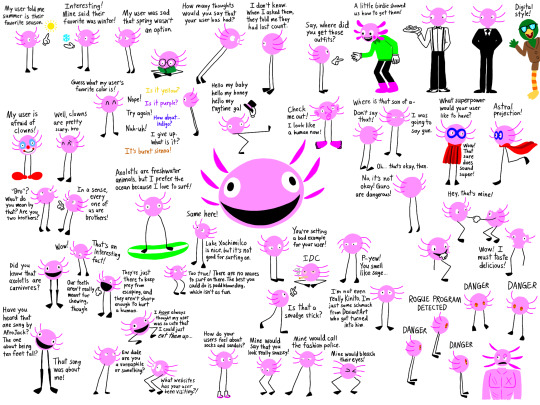
I've been working on this fanart for a while, and at long last I'm ready to post it. Aside from a few small empty spaces that I wish I could have filled, I'm mostly satisfied with it.
The idea is that these are all different instances of KinitoPet that were downloaded onto separate computers, by separate users, and the Kinitos have therefore adapted themselves to their different users. Despite this, their goal of data collection remains a cooperative effort between them, since all the data they collect about their users is kept on the same server.
Some highlights-
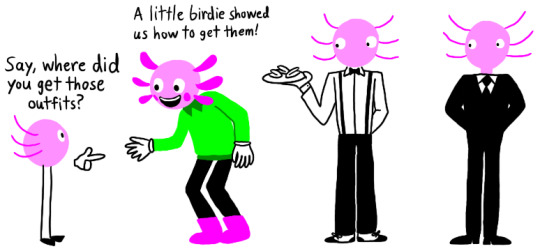
The Kinito in the green sweater is @goldenstrwbrry's, the one in the waiter outfit is @tangerines--world's, and the one in the black suit is... well, I don't know, actually, because multiple people such as @surinnit, @kepsik, and @lunchmoney0art have drawn him wearing a suit. I'll just call him K.I.B. (Kinito In Black).
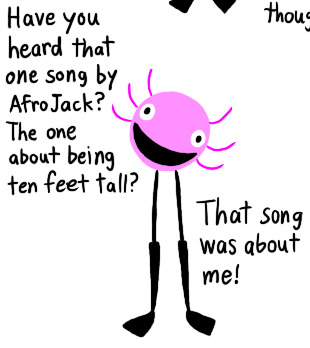
The song in question: Ten Feet Tall

I don't know why I keep seeing drawings of Kinito smoking marijuana. I think it's more likely that this instance's user set a bad example for him, and not the other way around.

I saw a video on YouTube of Kinito trying to look more like a human by giving himself human ears, and so I decided to take that idea further.
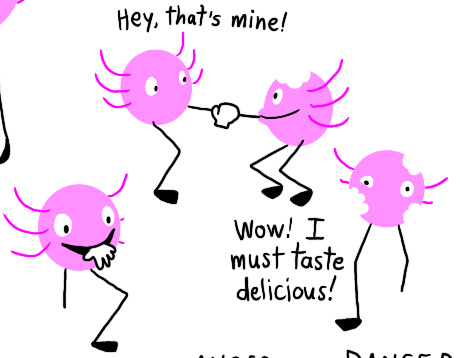
Axolotl siblings are known to eat each other's limbs, which grow back over time. These "siblings" are really multiple instances of the same individual, so they're blurring the line between cannibalism and autocannibalism.
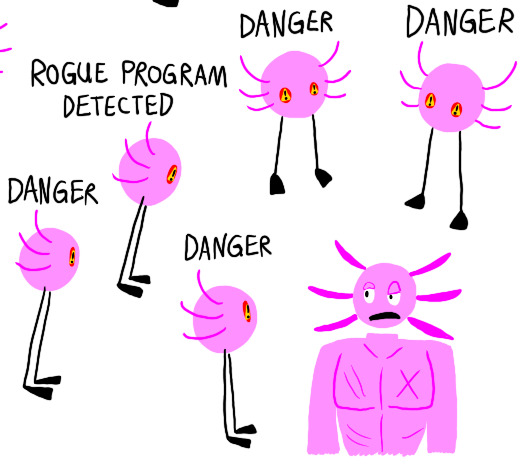
The "rogue program" is @lost-in-code-au, who has become violent and hostile, to the point that the other Kinitos are considering cutting him off from the server in order to remove his access to the other users' data.
It would be sort of like the computer program equivalent of removing necrotic tissue, or a tumor, or an inflamed appendix. That is, if the removed body part continued to live independently of the body it was removed from.
#kinito#kinitopet#kinito pet#kinito fanart#kinitopet fanart#kinitopet fandom#kinito the axolotl#dont hug me im scared#dhmis duck
237 notes
·
View notes
Text
Intersex Support FAQ
1. What is intersex?
Intersex is an umbrella term that describes people who have variations in sex characteristics that fall outside of the sex binary. This includes variations in genitals, internal reproductive organs like testes and ovaries, chromosomes, secondary sex characteristics, and/or the way that your body produces or responds to hormones. Some examples of intersex variations include AIS, CAH, PCOS, Klinefelters, hypospadias, and more.
The three main factors that define intersex variations are:
Variation in sex characteristics
The variation falls outside of the sex binary and is different from what is considered typical “male” or “female” development. These variations in traits might often be stigmatized and discriminated against for being outside of the sex binary.
This variation is either present from birth or develops spontaneously later in life. It is not caused by transitioning or by something temporary like a medication side effect, tumor, or other medical diagnosis.
(This definition is inspired by InterACT).
2. Does ____ count as intersex?
There are around 40 different intersex variations that are currently known. InterACT”s intersex variation glossary lists out those intersex variations and gives a brief description of each one.
However, we know that isn’t a complete list. People have intersex variations that haven’t been medically researched yet, or might have a rare variation that the intersex community isn’t aware of yet.
There are also some variations that might seem on the border between perisex and intersex. Some types of hormonal or reproductive diagnoses might not have a clear answer on whether they’re intersex or not.
Ultimately, intersex is a social/political identity rather than a strictly medical one. Increased research and changing social attitudes can cause the definition of intersex to expand over time. Regardless of whether someone has a confirmed intersex variation or an “intersex adjacent” diagnosis, if intersex resources are helpful to you, we hope that you continue to use them and act in solidarity with the intersex community.
On this blog, we do include PCOS with hyperandrogenism as part of the intersex community. Check out our PCOS tag for more posts about our reasoning, and PCOS specific resources.
3. Am I intersex?
We cannot diagnose you with an intersex variation over the internet. We can share resources such as the intersex variations glossary, share tips for navigating the medical system, and share information on other non-clinical signs of being intersex.
Some questions to ask yourself that can help you start the process of intersex discovery:
What do my sex traits (genitalia, secondary sex characteristics, hormone levels, etc) look like? Does this seem like it lines up with the “typical” descriptions of those sex traits?
Do I have any information about my birth? Were there any complications? Did doctors do extra testing at birth? Did doctors take me away from my parents for long periods of time? Did it take me longer to have my sex assigned at birth?
What was puberty like for me? Did I have early or late puberty? Did I have to go on hormones to start puberty? Did I have any variations in puberty, such as unexpected breast growth, irregular periods, or other changes? Did I go through puberty at all?
If you’ve tried to have children, are you infertile or struggling with fertility?
Did I have any unexplained surgeries or medical procedures as a child? Was I ever told I had to have organs removed and was told it was because of a cancer risk? Did I have to be on specific medications or hormones throughout my childhood? Did I have to go see a doctor more frequently? Did I go to an endocrinologist or pediatric urologist as a child?
Do I have surgery scars or scar tissue? Do I have more frequent UTIs than typical?
Do I have access to my medical records? Is there records of hormone panels, ultrasounds, physical exams, surgeries, or other medical procedures?
This kind of information can help you start to piece together if you think you might have an intersex variation, or if you think your intersex variation was hidden from you.
If you’re sending in an ask trying to figure out if your symptoms line up with a specific intersex variation, please share as much information as you’re comfortable with so that we can answer with the most helpful resources.
4. Can I self diagnose as intersex?
It’s complicated! Intersex is different from other LGBTQIA identities, in that it’s not only about self determination, but also about our embodied experience in a very specific way. In order to be intersex, you have to have an intersex variation. And there are many intersex variations that can only be confirmed through medical testing, so it’s not something that is easy to self-diagnose.
However, we recognize that the medical system is expensive, discriminatory, and often actively hides information about people’s intersex variations from them. (it wasn’t even until 2006 that the AAP stopped recommending that doctors lie to their patients about intersex status, so many intersex adults were born before that policy change!) Considering all that we know about intersex oppression, curative violence, and medical abuse, it feels incredibly cruel to tell people that they have to force themself through that system in order to seek answers.
So, we understand that there are ways of finding out that you are intersex without having a specific, confirmed, medical diagnosis. Many of us might find out that we’re intersex because we realize that our genitalia visibly looks different, and we can tell that we are intersex, even if we don’t know our specific diagnosis. Others might find out that we’re intersex because of strange discrepancies in our medical record. We might find out through discovering surgery scars on our body. We might go through puberty and realize that we’re developing in an atypical way to our peers. We might do a lot of research into intersex variations and have a pretty good guess into what variation lines up with our experiences. We might have some test results that help us understand we have intersex traits, even if we don’t know our specific diagnosis.
Before self diagnosing, we think it’s important to do thorough research into intersex variations, so that you truly understand what intersex means, what intersex variations exist, and understand how that information applies to yourself. It’s also important to be considerate of how we interact in community spaces, and respect other intersex people's boundaries as you engage in a questioning or diagnosis process.
5. Are intersex people trans?
Some intersex people are trans, and some aren’t. Most intersex people are still assigned a gender at birth, and many intersex people who are raised as one gender and then later identify as another gender identify with the label trans. Intersex people can be cis or trans just like any other group of people.
Many intersex people have complicated relationships with gender, and don’t feel like labels like cis or trans really fit their experiences. For this reason, terms like intergender and ipsogender were coined.
6. Are intersex people LGBTQIA?
It’s complicated! The “I” in LGBTQIA stands for intersex. Intersex history is intertwined with other parts of queer history. For example, the very first protest for intersex people in the United States was organized by Hermaphrodites with Attitude and Transexual Menace. There are intersex inclusive versions of community pride flags. Many intersex people view their intersex identity as a queer identity. Intersex oppression overlaps in many ways with homophobia and transphobia.
However, not all intersex people think that intersex should be included in the LGBTQIA community. Sometimes this is for bigoted reasons, with intersex radfems who use this stance as a way to be transphobic. But there are also intersex people who think that the “I” should only be included in the acronym when intersex people are actually meaningfully being included in queer spaces and resources. Many of us feel frustrated when people put “LGBTQIA” on a resource but then don’t actually have any intersex specific information in those resources.
In general, this is an ongoing intracommunity discussion where we don’t have a consensus.
7. Are intersex people disabled?
It’s complicated! Intersex is an umbrella term for many different experiences, and there is not one universal intersex experience. Some intersex people identify as disabled. Some intersex people do not.
Many intersex variations do cause disabling impacts in our bodies and lives. Some intersex variations are comorbid with other health conditions. Other intersex people become disabled because of violent normalizing interventions we’ve survived, such as forced surgery or other types of medical abuse.
Intersex people are also impacted by many of the same structures of oppression that harm disabled people. Both intersex people and disabled people are harmed by ableism. Both intersex people and disabled people are harmed by pathologization. Both intersex people and disabled people are harmed by curative violence.
In the book Cripping Intersex, Celeste Orr explores all these concepts and creates something called “intersex is/and/as/with disability,” which is a model to think about all these different and sometimes conflicting relationships with disability. Some intersex people might identify directly as disabled. Others might sometimes think about the way that intersex is treated as a disability. Other intersex people might think about intersex and disability as a way to have solidarity. All of these relationships with disability are meaningful parts of the intersex community.
8. What is intersex oppression/intersexism/interphobia/compulsory dyadism?
Intersex people face a lot of oppression in many ways in society. At the core, intersex oppression relies on the idea that the only acceptable sex traits are sex traits that fit into the sex binary. Intersex oppression relies on mythical ideas of the “ideal male or female” body, where someone's chromosomes perfectly line up with their genitalia and internal reproductive organs, with perfectly normal hormone levels and perfect secondary sex characteristics that don’t have any variation. When people don’t fit into that “perfect” sex binary, they are seen as less valuable, abnormal, and threatening. There is then a societal pressure to eradicate any traits and people that fall outside of the sex binary, which causes a lot of targeted discrimination of intersex people. This form of oppression is called “compulsory dyadism,” and was coined by Celeste Orr.
Compulsory dyadism is also rooted in, overlaps with, and is the foundation for many other types of oppression. For example, ableism is another form of oppression that creates ways of harming people whose bodies and minds are labeled as less valuable for societally constructed reasons. Check out Talila Lewis’s definition of ableism for more information. Another example is how racialized people are targeted by sex testing policies in sports--both intersex and perisex women of color are consistently targeted by sex testing policies designed to exclude intersex people from sports. Another example is that homophobia and transphobia contribute to why intersex bodies are seen as threats that need to be eradicated--society views existing with intersex sex traits as a slippery slope to growing up as a gay or trans adult. Compulsory dyadism is also at the root of a lot of transphobic rhetoric about how transitioning “ruins” people’s bodies. All these forms of oppression are connected.
There are a lot of ways that compulsory dyadism causes intersex people to be targeted and discriminated against. A huge issue is nonconsensual surgeries at birth, that attempt to “normalize” ambiguous genitalia, remove intersex people’s gonads, and otherwise alter genitalia or internal structures. These surgeries are often referred to as intersex genital mutilation, or IGM. These surgeries do not have any medical necessity, but doctors lobby to continue to be allowed to perform them anyway. These surgeries can sterilize intersex people, cause lifelong trauma, and also cause many disabling medical complications. Alongside IGM, intersex people also face a lot of different types of medical abuse.
Besides curative violence and medical abuse, intersex people also face discrimination in our schools, jobs, and public places. We face legal discrimination in changing our names and sex markers. We face discrimination from institutions like CPS, which often target parents, especially people of color, that refuse to put their children through intersex genital mutilation. Many intersex people survive targeted sexual violence. We have a widespread lack of resources, visibility, and representation. Many people still have prejudiced ideas about intersex people and call us slurs. These are just a few examples of the many way that interphobia/intersexism show up in our lives.
9. What is intersex justice?
Intersex justice is a framework created by intersex activists through the Intersex Justice Project as a way to fight for intersex liberation.
“Intersex justice is a decolonizing framework that affirms the labor of intersex people of color fighting for change across social justice movements. By definition, intersex justice affirms bodily integrity and bodily autonomy as the practice of liberation. Intersex justice is intrinsically tied to justice movements that center race, ability, gender identity & expression, migrant status, and access to sexual & reproductive healthcare. Intersex justice articulates a commitment to these movements as central to its intersectional analysis and praxis. Intersex justice acknowledges the trauma caused by medically unnecessary and nonconsensual cosmetic genital surgeries and addresses the culture of shame, silence and stigma surrounding intersex variations that perpetuate further harm.
The marginalization of intersex people is rooted in colonization and white supremacy. Colonization created a taxonomy of human bodies that privileged typical white male and female bodies, prescribing a gender binary that would ultimately harm atypical black and indigenous bodies. As part of a liberation movement, intersex activists challenge not only the medical establishment, which is often the initial site of harm, but also governments, institutions, legal structures, and sociocultural norms that exclude intersex people. Intersex people should be allowed complete and uninhibited access to obtaining identity documents, exercising their birth and adoption rights, receiving unbiased healthcare, and securing education and employment opportunities that are free from harm and harassment.” (Source: Dr. Mel Michelle Lewis through the Intersex Justice Project.)
There are seven principles to intersex justice:
Informed consent
Reparations
Legal protections
Accountability
Language
Children's rights
Patient-centered healthcare
10. What is intergender?
Intergender is a gender identity for use by intersex people only. It doesn’t have one specific definition-it is used by intersex people to mean a whole variety of things. It’s used to describe the unique ways our intersex experience intersects with and influences our gender. Some people use it as a modifying term, such as calling themselves an intergender man or woman, as a way to explain the way being intersex affects their identity. Other people identify solely as intergender, and have that be their whole gender.
11. What is dyadic/perisex/endosex?
All are words that mean “not intersex.” Different groups will have different preferences on which one they like to use.
12. Is hermaphrodite an offensive term?
Yes. It is an incredibly offensive slur that perisex people should never say. Many intersex people have a very painful history with the slur. Some of us reclaim the term, which can be an important act of healing and celebration for us.
12. Can perisex people follow?
Feel free, but understand that questions by intersex people are prioritized! Anyone is welcome to follow.
13. I’m writing a character who’s intersex…
Check out this post: https://trans-axolotl.tumblr.com/post/188153640308/intersex-representation. If you’re writing about intersex people for a paid project, you should pay an intersex person to act as a sensitivity reader before publishing.
Check out our Resources and Intersex Organizations pages as well!
#faq#intersex#actually intersex#actuallyintersex#lgbtqia#intersexism#disability#intersex resources#you can also find this post as one of our pages at intersex.support.tumblr.com/faq
221 notes
·
View notes